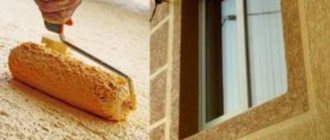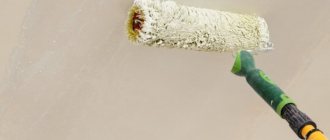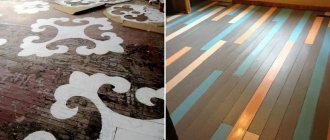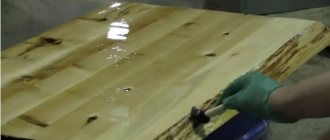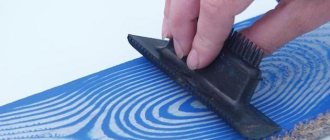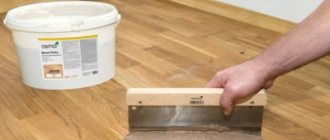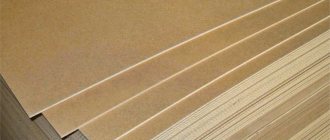To protect wood from rotting, drying out, and premature wear, it is varnished or painted. Moreover, for the steps you should choose especially durable paints that can withstand daily loads.
Wooden interfloor staircases are common in private housing construction. Wood is an easy-to-work material from which you can make a durable and beautiful structure, but it requires special care.
To protect wood from rotting, drying out, and premature wear, it is varnished or painted. Moreover, for the steps you should choose especially durable paints that can withstand daily loads.
Don't forget to share with your friends!
- Rules for choosing material Varnishes
- Paints
- Impregnations and stains
- Oils
- Detarring
- varnishes
- paints
- enamels
- impregnation
Types of painting mixtures
In order to keep the wooden structure safe and sound, as well as to give it a presentable appearance, there are many types of mixtures:
- Stains;
- Lucky;
- Water-based paints with excellent protective properties;
- Traditional paints;
- Enamels.
Your choice will depend on how much you want to preserve the natural color of the wood, as well as its structure. Paints with high tinting power, such as alkyd enamels, will not allow this, but you may not need it. But translucent tinting compounds will change color, but the structure of the wood will remain visible. The color range of such paints is small, but it contains all the basic natural colors. Sometimes they are completely colorless, in which case the coating will simply perform a protective function.
Tint paints don't last long, so it's wise to protect them too by applying a varnish over the paint. This will also be beneficial from an aesthetic point of view. At the same time, it is absolutely not necessary to choose a glossy varnish - there are matte and semi-matte, and they will look more appropriate on the stairs. Among other things, the varnish coating will additionally protect the wood from all of the above destructive factors.
Paint functions
So, a high-quality multi-layer coating of the stairs with your own paints will reliably protect the product from the influence of many negative factors:
- Moisture;
- Pests;
- Mechanical impact;
- Deformations due to changes in humidity in the room.
Preparatory stage
The surface preparation process consists of several stages:
- Before painting, all surfaces of the structure must be sanded with fine sandpaper along the wooden fibers, as shown in the video. If there are cracks, chips and gouges on the tree, they should be smoothed out using a special putty - it is intended specifically for wooden surfaces. Any other putties do not provide sufficient adhesion to the structure of this material and quickly peel off. Following the instructions on the package, dry the putty and then sand the treated areas with sandpaper yourself. A few days after finishing the putty work, the entire structure must be sanded again. Then the surfaces will become especially smooth, and the staircase will take on an attractive appearance. After this, you need to thoroughly clean everything from dust using a vacuum cleaner;
- The next stage of work will be priming the surfaces. The primer is necessary so that the wood absorbs the required amount of moisture and no longer absorbs paint. Firstly, this allows you to reduce paint consumption, and secondly, it improves the adhesive properties of the surface and increases the service life of the paintwork. We also choose a primer specifically designed for woodwork. We maintain the time specified in the instructions on the package with the primer.
Main stage
Now you can start painting. They begin work with small structural elements - handrails, balusters, racks. The steps are painted last. It is better to use a roller for them.
Let's sum it up
A wooden staircase in a house has always been considered not only a functional structure, but also a decorative element. How long it will last and maintain its aesthetic appearance will depend on the quality of coloring.
Painting stairs step by step
Paint the wood with varnish using a spray gun or roller. The quality of the brush coating will not be up to par. Yes, and getting a very thin layer with it will be problematic. Only enamels and oil-based compositions are allowed to be applied with a brush.
Let us tell you in detail how to paint a wooden staircase in a house:
- It is more convenient to process it disassembled, before installation. If the staircase is already in use, you can paint it across the step. The rest can be processed after drying.
- The steps of a wooden staircase in a house must be coated with the most durable varnish or paint. Its remaining parts can be painted with any paint and varnish material.
- To reduce the risk of peeling, the varnish or primer is applied to a well-dried base.
- Naturally, processing must begin from the top step.
- The paint or varnish is carefully rubbed into the surface in a cross- or arc-shaped manner without gaps so that even the smallest depressions are completely painted. The last strokes are made not across, but along the fibers.
- Too thick a coating, especially varnish, is unacceptable. The layer will be inelastic and will crack quickly.
- To obtain an aesthetically attractive finish, untreated wood is painted or varnished 2 or even 3 times. The second layer is applied after the first has dried.
- The drying rate is significantly influenced by room temperature, humidity, and the presence of ventilation. In order for the painted surface to be well strengthened, it is better to start using the stairs a little later than indicated in the instructions for the paint and varnish material. After all, a small drip may form somewhere, which will take longer to dry.
Even before purchase
Before deciding which option will be the best solution in your case, you need to analyze the following points:
Impact of precipitation. This is true for stairs that are located on the street. The amount of sunlight received. The composition of the coloring agent for a staircase, which is under direct ultraviolet exposure most of the day, differs from that which can be used if the product is located in the shade. This also affects the final cost. Gloss or matte. Typically, a coating that has a matte or semi-matte structure is selected for stairs. This makes more sense from a usability point of view. A glossy surface wears off faster and loses its appearance. Although there are types of varnishes that are able to maintain shine and at the same time are resistant to physical impact, for example, “yacht”. Hue
It is important to decide whether a slight adjustment will be made to the tone or a complete color substitution will take place. How much time is there for drying and will people be in the room during this time? Will you do the painting yourself or leave it to the professionals?
Technology
So, we have decided how to cover a pine staircase. You can start working. Where to begin?
One of the typical problems of pine has already been mentioned: resin. The resin content of the fibers and, most importantly, the resin pockets. How to get rid of this scourge?
Acetone or turpentine can help. Both solvents are excellent at removing traces of resin and dissolving resin accumulations in pockets. For cleaning use ordinary rags.
Turpentine dissolves all natural resins.
The best choice in our case is acrylic wood putty. Irregularities, cavities from knots and resin will have to be puttied 2-3 times with intermediate sanding: the putty shrinks when it dries.
If painting is to be done, the color of the putty does not matter; but when varnishing it is better to match it to the tone of the wood. The exception is the case when the final coating is dark tinted varnish: white patches on a light background under its layer will not be noticeable.
A sander can be used on the planes, but the balusters, the surface of the steps between them and the handrails will have to be sanded by hand. For sanding, you will have to stock up on several types of sandpaper with different grits: trying to jump from 60 to 120 grit will only be a waste of time. You shouldn’t treat the stairs with zero polish: save it for interlayer sanding of the paintwork.
A sander will speed up the processing of flat surfaces.
Painting a pine staircase is done with a brush: do not spray alkyd enamel or viscous varnish with a spray gun; the surface of the staircase has too complex a shape for a roller. Painting is carried out in at least three layers; polyurethane varnish can be applied on steps and in 6-7 layers: it performs not only decorative functions, but also provides reliable protection against mechanical damage.
After applying the first layer and drying it completely (regardless of whether we are talking about enamel or varnish), the entire surface is sanded with a zero polish. Enamel or varnish will inevitably raise the pile, but leaving the surface rough is not in our interests. Ideally, all layers except the final one are sanded.
Please note: before painting and varnish work you will have to do a general cleaning of the room. Dust can disfigure any coating
The time spent sanding will pay off in the appearance of the staircase.
What is the best way to paint a pine staircase?
- The optimal means for covering a pine flight of stairs are enamel paints, as well as alkyd and polyurethane yacht varnishes.
- To preserve the beautiful structural pattern of wood, diluted products are used.
- To hide defects in the material or give it a new shade, the paint is not diluted before application.
- In order for the coloring matter to lay down in a beautiful, even layer, the surface should be cleaned of debris and dust.
- Pigmented dyes are used to mask defects on steps.
- For previously painted structures, urethane-alkyd solutions are used.
Types of paints and varnishes
To give the staircase a finished look, several types of paint and varnish coatings are used. These are varnishes, impregnations and paints themselves. The former emphasize the structure of the wood (tinting) or fix the result (transparent), the latter also emphasize the beauty of the wood pattern, but require additional fixation with a transparent varnish. The paints allow you to paint the stairs as you please.
Coloring is done not only for aesthetic purposes. On the floor, tongue and groove pine boards are most often used. Despite its strength, unopened wood wears out 5 times faster. This is due to the fact that dust and grains of sand become clogged in the pores, which over time destroy the structure of the floorboards. By painting a staircase made of pine or any other wood with varnish or paint yourself, you extend its service life.
Clear/tinted wood varnish
Varnish is used to cover steps, balusters and railings. The colorless composition does not hide the wood texture
It is very important that the sanding of all elements of the staircase is carried out at the highest level. Transparent varnishes come in several types:
- Latex. Non-toxic material, safe for humans and animals. When applied to wood, it forms a thin, durable, water-resistant layer. It has antiseptic properties - protects wood from mold and rot. Can be used both indoors and outdoors.
- Water-based or acrylate. It has no unpleasant odor, is non-toxic, forms a fairly durable coating that is resistant to mechanical damage, and prevents the aging of wood.
- On synthetic resins. Such varnishes dry quickly, are resistant to aggressive environments (alkalies, acids), and are used only for interior work. Do not use synthetic resin varnishes to paint steps. They are suitable for balusters and railings.
- Yacht. There are different types, depending on the base - alkyd and its varieties (urethane-alkyd, alkyd-urethane) and acrylate. It is toxic, so when using it inside a living space, wear a respirator, otherwise the probability of poisoning is 99%.
Advice! Use clear yacht varnish to paint stairs only as a last resort. It is poisonous even after drying.
Tinting varnishes include oil-based compositions. With their help you can change the color of wood from pale yellow to rich brown. When choosing, you need to look at what percentage of oil is included in the composition. To paint the steps of the stairs, this parameter must be at least 65%. In this case, you will get a durable, wear-resistant coating. If the oil varnish contains only 50% oil or less, there can be no talk of any strength. This composition is suitable only for balusters and railings.
Wood paints
You can find a great variety of different formulations on sale. But which one is suitable for painting wooden stairs? To answer this question, you need to consider the types of paints used for wood:
Advice! Alkyd paints for wood give consistently good results. Choose them if you want to save a little money and get high-quality staircase coverage.
What can and should be used to cover a wooden staircase?
To give flights of stairs a finished look, several types of paint and varnish coatings are used:
- varnishes that can highlight the beauty of the structure of natural wood and enhance its appearance;
- impregnations help to highlight the features of the texture, make it richer, change the shade, giving the appearance of expensive types of wood. Additional treatment with transparent varnishes consolidates and preserves the resulting effect for a long time;
- Opaque paints make it possible to create something new. There is scope for designers; they can completely change the appearance of the entire structure. The most unusual ideas are embodied.
Wood varnish
Attention! If there is no coating on the treads, then the wear of the outer layer can be quite intense. Unprotected wood, even hardwood, experiences abrasive effects from shoes and brought in sand and dust particles. They penetrate between the planks, dramatically worsening the appearance of the product. After just a few years of intensive use, wear can be observed: in some places the surface layer loses its original state. The paint coating provides active protection for many years to come.
Paints
Painting balusters
Currently, several types of dyes are used to provide an opaque coating. The concept of oil paint has long since disappeared, although some people still use similar names. Paint for wooden stairs in a house can be alkyd, acrylic or thick rubbed.
Alkyd enamels are created on the basis of organic solvents. They contain:
- pigments that set the required shade;
- Solvents are substances that maintain the working mixture in a liquid state. The most commonly used is butyl alcohol. It evaporates quite quickly. The vapors do not cause allergic reactions in most people;
- binding materials. In finished formulations they are dissolved in alcohols or similar liquids. As the solvents dry, polymerization occurs. At the end of the process, a durable film is formed;
- fillers are inert components. They contribute to the formation of a thick and durable film. Most often, chalk or quartz sand crushed to a dusty state is used. The presence of filler contributes to better hiding power of alkyd enamel.
Alkyd paints are produced:
- for internal use. These compositions use fillers that can swell in a humid environment. They are cheaper, but when used outside they quickly lose their properties;
- for outdoor and indoor use. Such compositions do not absorb atmospheric moisture. The pigments included in the composition retain color saturation under the influence of ultraviolet light. The paint layer resists temperature changes, as the binders remain elastic for several years.
Acrylic paints contain resins obtained by grinding acrylic resins. Such paints and varnishes are made water-dispersed. If necessary, they can be partially diluted with plain water.
Similar painting materials have a wide variety of fillers used. Some, for example, latex ones, after painting and polymerization, can change geometric parameters: stretch and shrink.
Painting stairs with acrylic paints
If you want to get an opaque coating, this will be the best paint for a wooden staircase. Its positive characteristics are:
- absence of odor during painting work;
- high drying speed. Within two to three hours the layer is completely polymerized. After 6-8 hours, a fairly dense film is formed that can withstand abrasion and mechanical stress;
- a vapor-permeable coating is formed. Air circulates through the paint layer;
- The user has a wide range of shades. You can use white paint as a base, and then get the desired shade by adding the desired pigment. If necessary, use several different colors (usually no more than three, so as not to get dirt).
Wood paint RENOTON
Thickened paints are made by mixing drying oil and pigments. Chalk is added as a filler. Typically, this path is chosen when it is necessary to save on painting materials.
- Use inexpensive drying oil.
- Add chalk.
- The coloring pigment is added.
- Then the paint is mixed using special mixer-grinders.
In a couple of hours of operation of the unit, several hundred kilograms of finished paint are obtained. You can try similar compositions for painting stairs. But you should know that such a coating will not last long. Within two to three years the paint layer will be destroyed.
Lucky
Tinted wooden staircase under varnish
Varnishes are transparent and tinted solutions; after polymerization, a film is formed. They can be:
- Matte. The surface will not reflect light entering the surface;
- Glossy. Any ray that hits the treated surface will be completely reflected from it;
- Semi-gloss. Partially incident rays will be absorbed by the painted surface. Some of the light will be reflected.
The following is used as a base when creating varnishes:
- Alcohols . Such coatings provide reliable protection against dampness and biological damage by insects and fungi. Quite often, when creating multi-layer protection, alcohol products are used as a primer. Subsequent layers will adhere more firmly to the surface.
Types of varnishes from the St. Petersburg manufacturer Novbytkhim
- Alkyd and alkyd-urethane varnishes are created on the basis of aldehydes, soluble in organic solvents. They have a slight cream or pale yellow tint. They form quite strong connections with wood, since some of the components penetrate into the pores of the base. Such transparent layers work well not only indoors; outdoors they can protect wood from external influences for up to ten years.
Alkyd-urethane enamel for wooden stairs and floors
- Formaldehyde varnish has very significant wear-resistant properties. There are not only binders here. The presence of transparent resins contributes to the formation of a thick, durable and elastic film. Unfortunately, such materials have a persistent odor that persists for a long time.
Varnishing of staircase elements
- Polyester varnishes are a two-component composition. They harden only in the presence of a hardener. Therefore, before use, mix the resin and hardener. The resulting consistency will turn into a dense transparent mass in a day at a temperature of 20 ⁰C or more.
Varnish PF-283
- Epoxy varnishes are also a two-component solution. The base contains resin. The hardener promotes rapid curing. It should be remembered that most hardeners are toxic. But after polymerization is completed, toxicity quickly decreases. Harmful substances enter into chemical reactions and are completely converted into water-insoluble components. The mechanical strength of these connections is the highest. However, the price often deters potential users.
Lacquered hardwood staircase
- Polyurethane varnishes are one-component structures. There is a peculiarity: they acquire their strength in the presence of water. It is a catalyst for starting the polymerization process. The speed of setting surprises uninformed specialists. It often takes only a few minutes from the moment the varnish is applied to complete the process. But the layer thickness should be minimal. If this condition is not met, the structure may foam and quality will be lost.
Yacht varnish
- Yacht varnish is based on butyl alcohol. The existing binders form a fairly strong film. It does not dissolve in fresh and salt water. This is an expensive product, but professionals often choose it.
Impregnations and stains
Tinting solutions are used as stains and impregnations. They are created on a water, alcohol or alkyd basis. The difference from varnishes and paints is that there is a binder and pigment. There are no fillers.
Basic color palette of stains
Some craftsmen use not only well-known stains for their work; they prepare their own solutions. Some experts prefer to take a solution of iodine in alcohol. Dilute it in water, achieving the required saturation.
Others make tinctures of willow or oak bark. By soaking the bark for several days, tannins are released. The result is a dark brown solution that lasts and does not fade for quite a long time.
To obtain the desired shade, select the necessary stain and then apply it to the surface of the wood. Use tampons, brushes or rollers.
Basic requirements for processing and painting staircases
Painting a wooden staircase must meet certain requirements.
After all, the final result depends on the competent choice of materials for wood processing:
The dyes themselves are slightly diluted before processing wood to improve consistency. In this form, the base is better distributed over the surface and dries faster.
Attention: The best result can be achieved by painting in 2-3 layers
It is equally important to choose the right tool for applying paint - brushes, rollers with various attachments, a spray gun (spray gun)
- For interior spaces, wood can be processed minimally, especially if this is due to the aesthetics of its texture that you want to emphasize. Some craftsmen make real masterpieces, with wood carvings and special design elements. In such cases, the wood is not primed before varnishing, but hardwood is chosen, which is thoroughly sanded and the shade is slightly improved with stain.
- Depending on the expected effect, choose matte or glossy varnish; there is also a semi-matte finish. They all differ in the degree of light reflection. Staircases with a glossy sheen are not appropriate for every design. Matte varnish most emphasizes the beauty of the texture of wood fibers.
Attention: When treating stairs with paints and varnishes in interior spaces, toxic bases and reagents with a strong odor should be avoided! It is forbidden to work with facade paints and impregnations for exterior work, which leave a specific odor for a long time!
- The construction market offers eco-paints and almost odorless compositions for interior spaces. The same applies to solvents. It is better to use ready-to-use varnish or paint. If you cannot do without chemical reagents, then dilute the base to the desired consistency in an open space.
- The quick-drying dye is easy to use; after processing it sets well, leaving no odor. But they need to work quickly, with an experienced hand, apply in a thin layer and immediately remove sagging and smudges.
- Exterior paints are suitable for painting stairs on the outside of the house. Use any façade paint for wood processing. The instructions should indicate at what temperature the work is permissible and the drying time of the paints. It is undesirable to work in hot weather, rain and sub-zero temperatures. Wear work clothing and a protective mask when painting with exterior paint.
Attention: Incorrectly chosen paint and careless application will ruin the appearance of any staircase
At each stage, it is important to follow the recommendations in the paint instructions. A properly selected composition will improve the appearance of flights of stairs and reliably protect against external influences
A properly selected composition will improve the appearance of flights of stairs and reliably protect against external influences.
Preparatory work
- First, all existing construction debris is completely removed.
- If necessary, wash the levels and elements of staircases.
- Dry it.
- Assess the need for puttying and grinding work. They are performed if necessary.
Prepare the surface for finishing work.
Attention! If puttying is done, you will have to wait at least 48 hours for the solution to completely set. Then the excess is removed with abrasive materials and the surface is ground. It happens that such operations are performed several times.
DIY painting
DIY painting of pine stairs
Before painting the stairs, you should study the technology of the work. At the same time, I want to give some tips on how to paint a pine staircase in order to get a coating with maximum service life.
So, how to paint a wooden staircase made from solid pine:
The first step is to deal with the problem of pine - it's resin. To do this, use acetone or turpentine. These materials remove all tar manifestations, and the processing tool is an ordinary rag. At the next stage, preparatory work is carried out, which consists of filling the damaged areas. For this process, it is better to choose acrylic wood putty. Since the material shrinks when it dries, the mixture should be applied in 2-3 layers, and the surface should be sanded between layers. Since we will be painting our stairs in the future, the color of the putty can be any color. But if you have to apply varnish, then you need to choose a putty that matches the color of the stairs. Sanding is a mandatory and important activity. Using a sander will help you with this process, but be prepared for the fact that hard-to-reach areas will still have to be sanded manually. Sandpaper is used in different grits, but do not jump from finer to coarse grains. Zeroing during processing is used only at the sanding stage between layers. Painting of a flight of stairs should be done with a brush. Due to their viscosity, alkyd enamel and varnish cannot be applied using a spray gun, and the use of a roller is prohibited due to the complex surface. The material is applied in several layers, and if you decide to use polyurethane varnish, then prepare for the fact that the number of layers may increase to 6-7. After you have applied the first coat, let it dry well and sand it with fine-grade sandpaper.
This is important when using enamel or varnish for pine, since raising the pile interferes with a high-quality coating, and we do not need this at all. Do not forget that before starting any finishing work associated with coating with various paints and impregnations, you should very carefully clean the room, where is the pine staircase located. The fact is that dust can harm the appearance of the coating by settling on it at the most unnecessary moment.
The painting material must be of high quality, so think about choosing the type of paint in advance
Do-it-yourself painting of pine stairs
Cleaning of the room is carried out after work with surface grinding, as this process is very dusty. Before painting, several layers of primer should be applied, and if in this case the villi begin to rise and swell, then sanding and application of primer will need to be done again. When applying paint, which is thinner than varnishes, you can use a pneumatic sprayer - but do not forget to use a respirator. When several layers are applied, the second should be applied perpendicular to the first, and the third perpendicular to the second. Do not forget that subsequent layers can be applied only after the previous one has dried, this way you will not have smudges and the coating will be of the highest quality without color transitions. When you paint an already installed staircase, always start at the top and work your way down - this way you will not catch the already painted surface.
Never be afraid to do something with your own hands, because without trying you will never know about your abilities and if you succeed, then you can really save not only on purchasing a structure from available material, but also on carrying out the painting work itself.
Features of finishing of coniferous wood. Detarring
Due to the excess resin on the surface, painting pine and other types of coniferous wood is difficult. And the paint coating does not apply evenly on it. Therefore, before painting a pine staircase in a house, it must be deresined.
For these purposes, liquid compounds are used that can saponify or dissolve the resin. For a liter of water (heated to 60-80°C) you will need 50 g (about 3 tablespoons) of baking soda, 40 g of soap shavings, potash (50 g), 200 g of acetone and a little alcohol (10 g).
There is no point in processing the tree along the top. The resin will come up from the depths over time. Therefore, the most resinous places are carefully selected with a milling cutter and treated with a solution. Next, the holes are primed and covered with putty. You can remove small tarry discharges with regular gasoline.
It is better not to impregnate pine stairs with stain. Due to the lack of moves in the tree, it will be uneven. Pine varnish must be marked “for soft wood.”
Work technology
Tree to tree - discord
If you contact a specialized company to find out the cost of painting a wooden staircase, you will be unpleasantly surprised at a fairly substantial amount. That is why many of our compatriots have a desire to do the work with their own hands - especially since it is not particularly difficult.
First you need to pay close attention to the wood from which the stairs are made:
- Coniferous species (spruce, pine, cedar) have a high content of resinous substances, and therefore the paint on them holds somewhat worse.
- Hardwoods are characterized by sufficient density, and therefore it is easier to prepare them for painting.
- Fresh wood has a large number of open pores, which leads to abundant absorption of liquid components of varnishes and enamels.
- Old and dense wood should be properly primed, otherwise the paint will simply run off the stairs.
Preparing the stairs for painting
In any case, in order for the paint to lay flat and hold securely, the stairs must be carefully prepared:
At the first stage, we use putty to fill all the cracks into which paint may flow. To achieve the best result, you should use a special mixture for wood. (see also Oak stairs - manufacturing and assembly features)
Advice! To prevent putty stains from being visible through the varnish, its shade should be selected as close as possible to the color of the wood.
After the mixture has dried, we sand the putty with sandpaper so that we get a perfectly smooth surface.
Careful sanding will ensure a perfectly smooth surface.
- Ideally, you should wait two to three days after the first grinding and then repeat the operations. This will ensure the most complete polymerization of the putty mass.
- After completing the treatment, we remove dust from the surface, since even the smallest sawdust under a layer of paint or varnish will appear very prominently.
- We prime the stairs using a brush or roller, applying the primer twice with a break of 24 hours.
If possible, parts can be processed separately
Painting the stairs
Painting of wooden stairs begins after the second coat of primer has completely dried.
Before starting work, thoroughly mix the paint or dilute the tinting component in a transparent varnish (the instructions from the manufacturer will tell you how to do this).
Apply paint with a roller to the flat part of the steps
To apply the paint composition you can use:
- Brushes are wide, with natural or artificial bristles.
- Rollers.
- Paint sprayers.
- Spray guns.
Spray can be used
Below are tips specifically for using a brush, since this method is the most accessible:
- We start painting with the largest areas - railings, steps, stringers, etc. It is also worth moving from top to bottom, making sure that the flowing paint does not harden in drops.
- Place a small amount of paint on the brush. We remove the excess by brushing either along the edge of the jar or along a specially stretched rubber band around the neck.
- Holding the brush at an angle of about 45° to the surface to be painted, distribute the paint or varnish evenly.
- For the highest quality coating, you can apply from 2-3 to 5-6 layers. We lay each next layer only after the previous one has completely dried.
- When using tinted varnish, apply the darkest mixture to the wooden base. We make the top layers of varnish on the stairs almost transparent - this way we will give the stairs depth and emphasize the texture of the wood.
Photo of the varnished surface
The paint should dry at room temperature and normal humidity. Heat or cold will cause microcracks to appear on the surface of the stairs, which will very soon expand and cause the paint to peel.
We hope that thanks to the information presented in the article, you learned how to paint a wooden staircase as efficiently as possible. (see also Single-flight staircase: a simple solution) Believe me, such work does not present any special difficulties, and if you don’t rush, then very soon the steps in the house will shine with fresh colors or acquire a noble shine of varnish. In the video presented in this article you will find additional information on this topic.
How to paint a staircase in a house with paint or varnish
Depending on the type of wood and its quality, paint or varnish is chosen to cover wooden surfaces. The varnish will highlight all the beauty of the natural material, but only if the wood used to make the stairs was taken of high quality, without defects. Since both manufacturers and customers usually believe that the main characteristics of a staircase are strength and durability, the aesthetic component is relegated to the background. Sometimes an unpainted staircase can have visual imperfections, so it makes sense to hide them under a coat of paint. If you want to emphasize the advantages of wood, then this point should be discussed with the manufacturer in advance, and then the varnished staircase will become a decoration of the house.
The traditional way of decorating a staircase without using bright colors and decorative elements
The range of paints and varnishes is now huge and choosing the material that is optimal for your staircase is difficult, but it is possible by adhering to the following principles:
- If you plan to varnish the staircase, it is better to choose semi-matte or matte. Glossy varnish in areas of high load (railings and the central part of the steps) will quickly lose its shine, and the staircase itself will lose its appearance;
- if before using colorless varnish you plan to change the shade of wood using stains, you need to remember that some of them can noticeably darken the natural color of the wood, so it is better to first cover a small area with stain and then make a decision;
- If you decide to paint the stairs, then paint based on natural drying oil is considered to be of higher quality, although paints based on synthetic drying oil are also quite suitable for interior stairs.
Recommendations for choosing colors
There are no uniform and general requirements. But you need to remember that stairs are used to move between floors. A person must clearly see the steps on which he has to walk when going up or down flights of stairs.
Tinted staircase
If high-quality wood is used, then there is no point in hiding it under a layer of paint. In inexpensive structures it is possible to use inexpensive types of wood. Individual fragments can be assembled from small elements. Then an opaque coating is applied.
In rooms where children are present, bright colors are used to paint stairs. Little ones love to stomp on the steps, which are painted in different colors.
There are some general guidelines for painting with different colors.
- Begin painting with the lightest shades: yellow, pink, orange, light blue. More saturated colors are applied on top of light ones or next to them.
- Obtaining a dark shade is achieved by applying impregnation over light paint. The stain will definitely go inside the pores of the wood and give a darker color.
- Lightening is achieved using acids: citric, malic, acetic. It should be remembered that only solutions are required in which no more than 0.5...3.0% acid is present. At higher concentrations, the paint layer may be destroyed.
Choice of paint and varnish
How to paint a pine staircase? Or, if your choice is a varnish coating, what should you use to varnish it with?
It is worth separating the working surface of the steps and all other elements of the staircase: they have completely different modes of operation. The steps are subject to severe wear and tear; In addition, pine, as we remember, is a species with low wood density. Stilettos or hard heels may well leave marks on it if the strength of the protective layer is low.
On the other hand, handrails and accessories for stairs (bowstrings, balusters) and the back side of the steps are practically not exposed to loads. Any coating will serve mainly decorative functions - of course, in addition to protection from rotting and moisture.
Hence the choice of materials:
- For the working surface of the steps, alkyd-based floor enamels are used - domestic PF-266 and imported analogues. Brand preferences are deeply subjective, so we will not name specific names in order to avoid accusations of hidden advertising.
- The best varnish for pine stairs (more precisely, for the surface of the steps) is polyurethane parquet. Its price is quite high; but it forms an extremely durable and wear-resistant surface.
Advice: it is better to choose matte or semi-matte varnish rather than glossy. It shows less visible signs of wear, which will inevitably appear in the center of the steps, even after a long time.
Accessories for stairs: types and purpose
For surfaces that are not subject to intense mechanical stress, we can again recommend alkyd enamels PF-115 for exterior use. They are weather resistant but are not intended for painting floors. With varnishes it’s even easier: our requirements are fully satisfied with inexpensive nitrocellulose varnishes of the NTs series or alkyd PF-170.
Varnishes, oils and impregnations for wood
Beautiful texture, natural shades do not need decorative treatment if the wood has no defects. It is enough to emphasize the depth of color, enhance the natural shade with varnish - a composition that forms a hard film on the surface after drying. Varnishes are used for interior marches on the 2nd floor in a house or country house. There are different compositions:
- for external or internal work. Varnish coatings for exterior use are characterized by increased moisture resistance and resistance to temperature changes;
- according to the degree of gloss - matte, glossy, semi-matte. A staircase with a glossy sheen looks dazzling, but scratches and chips that form over time are too noticeable. On a semi-matte finish, signs of wear are least visible;
- solvent-based, aqueous.
Alkyd varnishes penetrate deeply into the wood, form a thick, dense film, but have an unpleasant odor and take a long time to dry. Oil-based ones dry within 12 hours, are not afraid of water - the surface can be washed.
Acrylic-based coatings, which contain liquid polymers, antiseptics, and plasticizers, are characterized by rapid drying, odorlessness, and high resistance to aggressive influences. The elastic film protects the surface of the wood from mechanical damage, does not dissolve in water, and does not turn yellow under the sun.
Water-based varnishes are more environmentally friendly, dry quickly, and are intended for finishing interior structures indoors. Manufacturers produce water compositions specifically for stairs in bathhouses and saunas, which are not afraid of moisture, can withstand temperatures up to +120 degrees, and allow wood to “breathe.”
Transparent varnish is used if the wood is free of defects or has a characteristic pattern, such as oak or beech. The coating can be tinted by selecting the desired color from the tinting card (up to 50-60 shades).
To cover wooden flights, experts recommend using wear-resistant varnishes - parquet, alkyd-urethane yacht, which are suitable for both home and outdoor systems. Manufacturers Herberts, Remmers, Caparol (Germany), Sadolin (Sweden) have proven themselves well. The service life of high-quality materials is 10 years or more. Inexpensive paintwork from unknown manufacturers often turns out to be toxic. In high-traffic areas, they wear out in 2-3 years, and replacing them will not be cheap.
Stains are compositions for tinting wood. The stain penetrates the structure, coloring the wood, while the texture remains intact. Impregnation is used:
- for protection against rotting and insect pests;
- increasing moisture resistance and service life of the stairs;
- for restoration of old surfaces, decoration.
Solutions are produced on different bases. An additional layer of varnish must be applied over the water-based stain. Alcohol compositions dry quickly, but it is not easy to achieve uniform color with them. The best coloring effect is obtained if the coating is applied with a spray gun. Acrylic and wax stains form a beautiful smooth surface that has water-repellent properties.
Colored oils and waxes tint the wooden surface, protecting it from abrasion, insects, and rot. Unlike varnish, they do not form a film, but permeate the wood, brightening the color and texture, and allowing the wood to “breathe.” A staircase impregnated with oil turns out matte, with a highlighted wood texture.
Wax creates a polishing effect. Impregnations improve the strength characteristics of soft wood (pine, spruce).
What factors are most destructive to a wooden staircase?
Stairs made of any material are subject to heavy loads. Under external influence, the structure of the wood is gradually destroyed.
Without proper treatment with special impregnations and protective paints, the structure quickly loses its presentable appearance, and partial destruction of the frame or steps is possible. The paint for a wooden staircase should be selected thoroughly (see Which paint is best to paint wood: making a choice).
The lifespan of a ladder depends on many components:
Design features - if the daily load corresponds to the quality and thickness of the timber from which the staircase is made, it will serve flawlessly for many years without major repairs.
Temperature fluctuations. air humidity and other atmospheric factors affect the quality of wood. This is most destructive when the wooden structure is located outside. In interior spaces there are fewer destructive factors, but over time the load becomes noticeable through a decrease in the strength of the base.
Wooden structures located on the south side of the house suffer from drying out of the fiber structure. Wood is a natural material with a certain percentage of moisture, which is necessary for its elasticity and strength. When exposed to direct sunlight, the percentage of moisture in wood decreases to a critical level
Therefore, it is important to paint it without waiting for the wood to dry out.
The places of the most intense load are the middle part of the steps and handrails. If the stairs are used in shoes, entering directly from the street, this is unfavorable for wood
It’s bad when the handrails are handled with unwashed or wet hands, wearing wet gloves; they should be protected the most.
The central part of the steps gradually wears off, they begin to creak and sag. Due attention should be paid to this when processing with impregnations and applying a finishing coating, which to a large extent preserves the natural material.
Painting a wooden staircase: tips for choosing a paint
Before you start painting the stairs, you need to decide exactly what kind of result you want to get. This will help you avoid making mistakes with the choice of dye and the technology for its application.
So, what do you need to keep in mind when starting painting:
- If the natural pattern of wood is so beautiful that you want to leave it, it is better to choose glossy or matte varnish instead of paint;
- To preserve the texture, you should abandon the use of primers, and you should purchase “light” paint that allows the wood to “breathe”;
- If painting inside the house, you need to ensure that the composition used has quick-drying properties and does not leave behind an unpleasant, long-lasting odor.
As for the steps, for their treatment you should select a paint that is distinguished by its durability and abrasion resistance. Otherwise, after a short time, the staircase will have to “experience” a new cosmetic renovation.
The paint must have protective properties to protect the wood from rot, dust, fungi and prevent it from losing its appearance.
Dyeing technology
Painting a wooden staircase takes place in 2 stages. This is preparing the base and, directly, opening the railings, balusters, and steps with varnish or paint. The first stage is very important; you cannot do without it if you want to get a beautiful and smooth staircase.
Preparing the base
To work, you will need a solution for removing old paint, wood putty or alternative methods of sealing cracks (wood chips, wood dust mixed with colorless varnish), an antiseptic primer, an iron brush, a spatula, sandpaper - 80, 100, 120, 180 - 220 , 240 – 320 and zero.
The technology for preparing the base with your own hands is simple:
- Remove debris from the stairs and wash them with water. Then wait until it dries completely.
- Treat the steps with old paint remover. Using a spatula, remove the swollen coating. Remove what hasn't risen with an iron brush.
- Clean the steps, balusters and railings with sandpaper, or preferably two – first 80-grit, then 100-grit, remove dust with a brush, and vacuum the steps additionally.
- Seal the cracks. The putty will not last long if the stairs are actively used. Try sealing the cracks with wood chips. Select a piece according to the size of the hole, coat it with PVA glue and place it in place. Another way to seal cracks: mix wood dust with colorless varnish, seal the cracks with the resulting composition and let dry.
- Go over it again with 120-grit sandpaper, remove the dust and finish the job with sandpaper. Ideally, the steps, balusters, and railings should be smooth “like an egg.”
- Treat the stairs with an antiseptic primer. Use a roller for this. Make sure that the composition gets into all the recesses and decorations (if any).
- Wait for the primer to dry.
Now you can begin the final stage.
Paint coating
This is a crucial moment. The quality of the coating determines the appearance of the staircase and how harmoniously it fits into the interior of the house. To work you will need paint and a brush/roller. You can use a spray gun (it costs significantly more than conventional tools for applying paintwork).
DIY paint application technology:
Open the jar. Using a long, strong wooden stick, stir the paint thoroughly. There should be no lumps in it. If the composition is excessively thick, dilute it with a solvent. Dip your brush or roller into the paint. Start painting. All movements should be along the fibers. After priming, the paint should not be absorbed too quickly. If you notice that the composition goes into the wood like a sponge, paint the entire staircase and wait until the first layer dries. Reapply paint
Pay special attention to the joints of the baluster/floor, baluster/railing, as well as various notches and squiggles (if there are shaped elements on the stairs).
Advice! After the paint has dried, open the stairs with clear varnish. This will increase the strength of the coating. As an option, paint only the steps, and varnish the balusters and railings.

